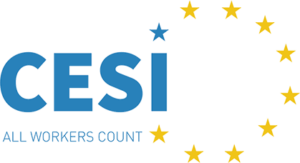2016-06-07 12:00
Last week Friday, CESI’s members’ training centre, the Europe Academy, held its first symposium of the year on impacts of new working rhythms in the public sector on the health of employees. The seminar, which took place in Copenhagen, was the first of two conferences of the Europe Academy this year in the framework of a project on ‘Health and safety at work in the public sector: new challenges’. The project is an important part of CESI’s awareness-raising work on healthy workplaces in the context of its role as partner of EU-OSHA’s Healthy Workplaces Campaign.
“It is important to continue helping public administrations in the set-up of awareness-raising and psychosocial risk prevention systems that form part of an overall policy to manage occupational risks and which is integrated into the social dialogue.” This was the message conveyed by the President of the Europe Academy, Emilio Fatovic, in his opening address of the symposium.
Europe Academy President Fatovic: Collective management of psychosocial risks at work vital
Fatovic, an affiliate of CESI’s Italian member organisation Confsal and also a long-standing representative in the European Economic and Social Committee (EESC), made very clear that it is the task of trade unions and trade union confederations like CESI to collect more evidence about positive and negative consequences of new work rhythms and to lead a discourse on concrete demands and measures. “It is more than ever important that employees are involved in the management of psychosocial risks at work”, Fatovic concluded.
Keynote address by Danish MP Bent Bøgsted
In his keynote address, Bent Bøgsted, Chairman of the Employment Committee of the Danish Parliament, agreed with this notion, stressing that, when properly managed, new work rhythms can bring benefits and win-win situations to both employers and employees. He cited well-regulated telework as a possible field of application.
A welcome speech was also given by Jørgen Jørgensen, Director of CESI’s Danish member organisation FF (Frie Funktionærer), which co-hosted the Europe Academy symposium together with Krifa (Kristelig Fagbevægelse), a Danish affiliate of CESI’s member Eurofedop.
Work-related sick leave still “unacceptably high”
In a presentation on the EU Strategic Framework on Health and Safety at Work 2014-2020, Zinta Podniece from the European Commission’s DG Employment, Social Affairs and Inclusion noted that according to the Commission, work-related sick leave, work-related diseases and accidents are still “unacceptably high” and put a “heavy burden” on competitiveness and public social security budgets. “Investment in occupational safety and health contributes to the well-being of workers and is cost-effective. According to recent estimates, investments in this area can produce high ratios of return”, she explained. She added that the EU Strategic Framework on Health and Safety at Work 2014-2020 and EU funds play a key role in the Commission’s strategy to encourage EU Member States and employers to improve the implementation record of applicable occupational safety and health (OSH) measures. Innovative ICT products and services, provided for through digitalisation, can also help them adapt workplaces and work organisation – including working time, workplace accessibility and workplace interventions targeted at older workers – to the needs of employees, Ms Podniece concluded.
Public sector workers prone to work rhythms that often lead to stress and absenteeism
Referring to preliminary results of Eurofound’s 6th European Working Conditions Survey (EWCS), Mathijn Wilkens from Eurofound explained how working time preferences are often not easily adjustable especially in public administrations, how health sector workers are particularly affected by atypical working hours and how many employees in the education sector have to work frequently during their free time. Stress and absenteeism can be a direct outcome of this.
Ongoing research on new working time models and solutions
Two speakers from the Finnish Institute of Occupational Health (FIOH) spoke on working hours, health, well-being and participation in working life and on working hours in knowledgede-intenstive work. Mikko Härmä presented a FIOH project on the creation of new working time models (‘WOW-project’), which aims at the development of guidance to trade unions to improve health, well-being and participation in working lives. Annina Ropponen highlighted that modern forms work organisation developed by the project might, for instance, help employees reduce their work-related smartphone use outside regular work hours.
Two case studies on wellbeing and OSH management in the public sector were presented by Barbara de Clippel from the Belgian Federal Public Service Social Security (FPS Social Security) and Mikkel Hundborg from Krifa. While Ms de Clippel outlined the human resources and OSH-strategy of FPS Social Security (‘Attract-Retain-Motivate-Engage’) – which includes a successful emphasis on employee-friendly digital telework – Ms Hundborg explained just how important functioning work-life balance instruments (such as well-regulated telework) are to keep employees motivated.
CESI Secretary General Heeger: Simply ignoring changes is not an option for trade unions
The symposium was wrapped up by a panel consisting of CESI Secretary General Klaus Heeger and representatives from member organisations and affiliates: José Fernández Vidal from the Spanish CSI-F, José Razafindranaly from the French FGAF and Rolf Weber from Krifa/Eurofedop. It was commonly agreed that new working rhythms, caused not least by ongoing digitalisation processes, is an evolving reality which trade unions have to engage in if they want them to happen in their favour. “Ignoring digitalisation and the changes it brings in terms of new working rhythms will mean that things will happen without us”, said Mr Heeger, adding that “trade unions must play a central and active role in practically assisting employers and authorities in the setting up of employee-friendly work environments that respond to new working rhythms.”
Further work by CESI on occupational health and safety
A Europe Academy conference in Madrid on October 14 will follow-up on the symposium in Copenhagen, then themed ‘Responsible players in the implementation of the OSH policy in the public sector in Europe: managers, trade unions, safety reps’. Thereafter, a CESI-commissioned study will be published on good practices in health and safety management in the public sector. The findings of the symposiums and the study will be disseminated via the ‘Healthy workplaces campaign‘ of the European Agency for Safety and Health at Work (EU-OSHA), where CESI is a partner.
Further information about this year’s Europe Academy project – including presentations and conference material – can be accessed in the Europe Academy section of CESI’s website.


